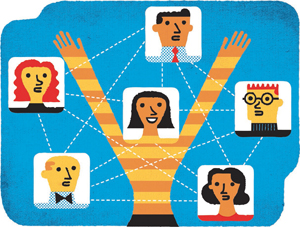In 1907, a group of investors that included J.P. Morgan took control of the American Telephone and Telegraph Company and named Theodore Vail president. (Vail had also been AT&T's president in the 1880s.) Roughly 6,000 independent phone companies had sprung up since Alexander Graham Bell's original patent expired in 1894, and Vail quickly embarked on a new strategy of acquiring them. Had these competitors not become part of the Bell system, Vail wrote in the company's 1908 annual report, "each little system would have been independent and self-contained without benefit to any other." A telephone without a connection at the other end, Vail explained, "is one of the most useless things in the world. Its value depends on the connection with the other telephone — and increases with the number of connections."
The term didn't exist at the time, but Vail was describing what's known today as a "network effect" or, by some economists, as a "network externality." Network effects occur when "the utility that a user derives from consumption of the good increases with the number of other agents consuming the good," as Michael Katz and Carl Shapiro of the University of California, Berkeley described in a 1985 article in the American Economic Review. (Shapiro later wrote a book about network effects with fellow Berkeley economist Hal Varian, now the chief economist at Google.)
In general, there are two types of network effects: direct and indirect. Direct effects occur when a good's value increases as the number of users goes up. Telephones exhibit direct network effects, as did fax machines before they were supplanted by email. Today, an oft-cited example of direct network effects is social media — the more friends you have using a given platform, the more enjoyment you'll get from it. An Internet search engine may also exhibit network effects; more users enable the company to refine the engine's algorithm, making it more effective and leading more people to use it. (See "Interview with Jean Tirole," Econ Focus, Fourth Quarter 2017.)
Indirect effects occur when an increase in consumers using a good leads to the creation of more complementary goods, thus making the original good more valuable. This is common in platform situations. For example, as more people use a particular videogame system, companies will create more games compatible with that system. Greater availability of games makes the system more attractive to future players, and competition among game developers drives down the price of games.
Robert Metcalfe, the electrical engineer primarily responsible for inventing Ethernet local networks, is widely credited with popularizing the idea of network effects. In the 1980s, Metcalfe's sales pitch for his new technology stated that the effect would be proportional to the square of the number of connected users of the system, a formula that came to be known as "Metcalfe's law." While there's little empirical evidence to support the law specifically, it's often still used as shorthand to assess technology companies' values.
Network effects can contribute to a situation known as "lock in," in which a particular standard becomes dominant and consumers find it very costly to switch. In these situations, the producer of the standard may be able to exercise monopoly power. In 1998, for example, the Department of Justice sued Microsoft for allegedly abusing Windows' ubiquity as an operating system to promote Internet Explorer. More recently, critics have contended that Google consistently manipulates its search results to direct users away from competing services in other markets that Google serves.
In addition, network effects don't increase indefinitely. Take a dating website, which initially becomes more useful as more people sign up and the number of potential matches increases. But after a certain point, there might be so many users that it's difficult for people to sort through the matches — a form of network "congestion." Congestion can also occur if a site or system's infrastructure is insufficient to support the number of users. Or, networks may become "polluted" if they reach a size such that the quality of each additional user declines.
It's also possible for an increase in users to create more value for one side of the market while detracting from the value for the other side. A website whose visitors increase will become more attractive to advertisers, but the increase in advertisers might then turn away some of those visitors. By many accounts, the ubiquity of advertising contributed to the demise of MySpace, which lost the social networking war to Facebook in the late 2000s. Today, many Facebook users complain about intrusive ads, but they continue using the site, in part because everyone else does — a testimony to the power of network effects.




